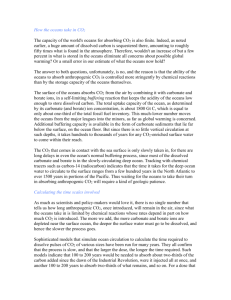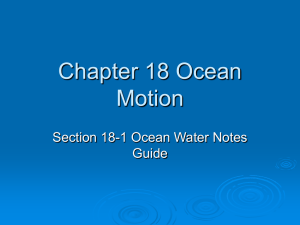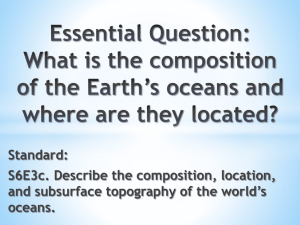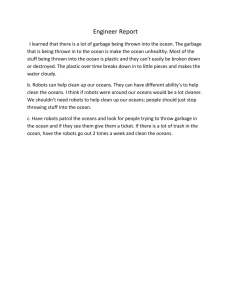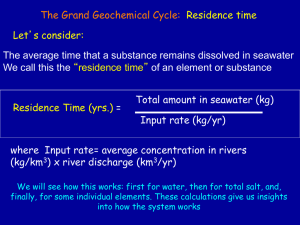A-Brief-Summary-of-Carbonate-Buffer-System
advertisement
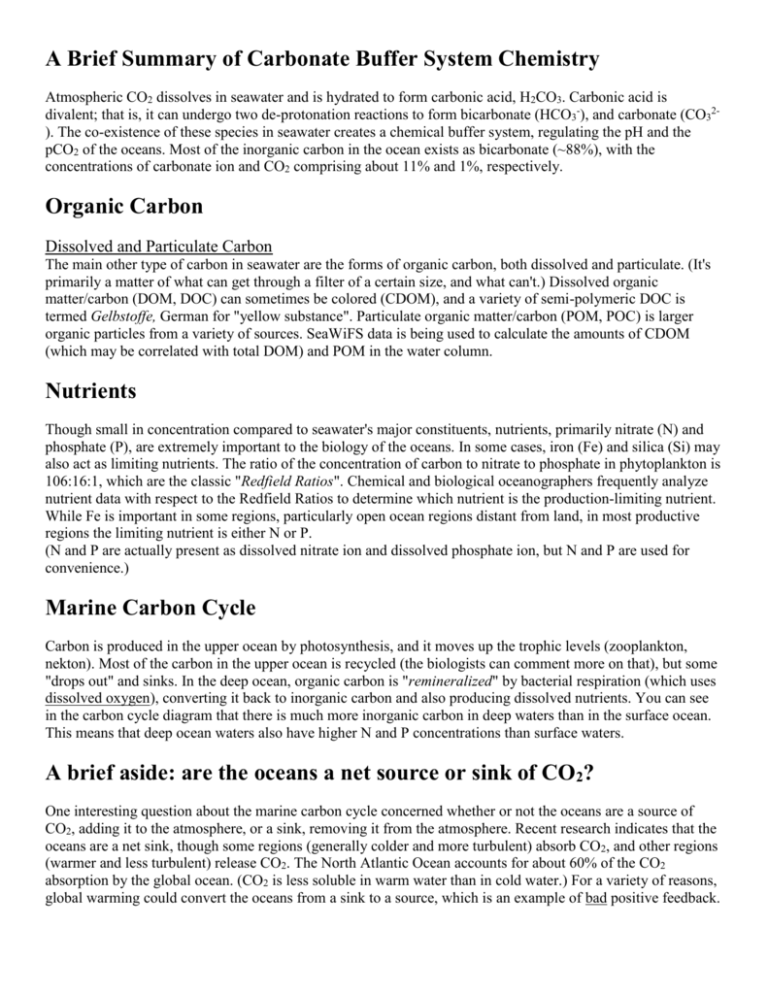
A Brief Summary of Carbonate Buffer System Chemistry Atmospheric CO2 dissolves in seawater and is hydrated to form carbonic acid, H2CO3. Carbonic acid is divalent; that is, it can undergo two de-protonation reactions to form bicarbonate (HCO3-), and carbonate (CO32). The co-existence of these species in seawater creates a chemical buffer system, regulating the pH and the pCO2 of the oceans. Most of the inorganic carbon in the ocean exists as bicarbonate (~88%), with the concentrations of carbonate ion and CO2 comprising about 11% and 1%, respectively. Organic Carbon Dissolved and Particulate Carbon The main other type of carbon in seawater are the forms of organic carbon, both dissolved and particulate. (It's primarily a matter of what can get through a filter of a certain size, and what can't.) Dissolved organic matter/carbon (DOM, DOC) can sometimes be colored (CDOM), and a variety of semi-polymeric DOC is termed Gelbstoffe, German for "yellow substance". Particulate organic matter/carbon (POM, POC) is larger organic particles from a variety of sources. SeaWiFS data is being used to calculate the amounts of CDOM (which may be correlated with total DOM) and POM in the water column. Nutrients Though small in concentration compared to seawater's major constituents, nutrients, primarily nitrate (N) and phosphate (P), are extremely important to the biology of the oceans. In some cases, iron (Fe) and silica (Si) may also act as limiting nutrients. The ratio of the concentration of carbon to nitrate to phosphate in phytoplankton is 106:16:1, which are the classic "Redfield Ratios". Chemical and biological oceanographers frequently analyze nutrient data with respect to the Redfield Ratios to determine which nutrient is the production-limiting nutrient. While Fe is important in some regions, particularly open ocean regions distant from land, in most productive regions the limiting nutrient is either N or P. (N and P are actually present as dissolved nitrate ion and dissolved phosphate ion, but N and P are used for convenience.) Marine Carbon Cycle Carbon is produced in the upper ocean by photosynthesis, and it moves up the trophic levels (zooplankton, nekton). Most of the carbon in the upper ocean is recycled (the biologists can comment more on that), but some "drops out" and sinks. In the deep ocean, organic carbon is "remineralized" by bacterial respiration (which uses dissolved oxygen), converting it back to inorganic carbon and also producing dissolved nutrients. You can see in the carbon cycle diagram that there is much more inorganic carbon in deep waters than in the surface ocean. This means that deep ocean waters also have higher N and P concentrations than surface waters. A brief aside: are the oceans a net source or sink of CO2? One interesting question about the marine carbon cycle concerned whether or not the oceans are a source of CO2, adding it to the atmosphere, or a sink, removing it from the atmosphere. Recent research indicates that the oceans are a net sink, though some regions (generally colder and more turbulent) absorb CO2, and other regions (warmer and less turbulent) release CO2. The North Atlantic Ocean accounts for about 60% of the CO2 absorption by the global ocean. (CO2 is less soluble in warm water than in cold water.) For a variety of reasons, global warming could convert the oceans from a sink to a source, which is an example of bad positive feedback.

